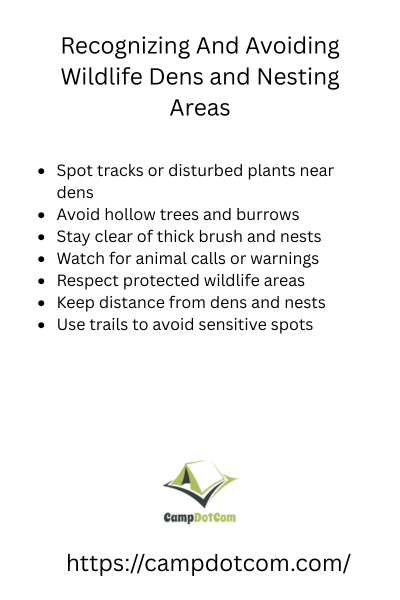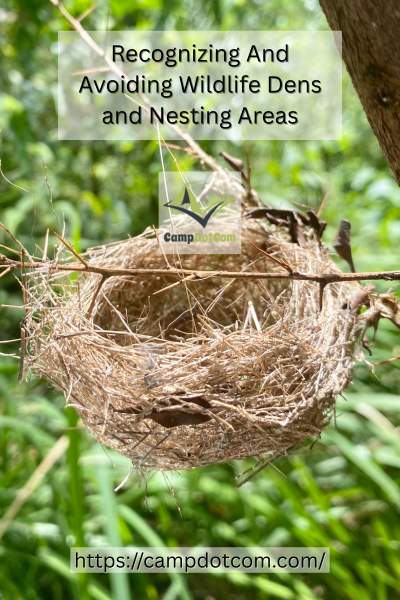Knowing how to spot and stay away from wildlife dens and nesting spots is not only important for your safety but also shows respect for nature’s limits. I found this out the hard way during a camping trip a few years back, and believe me, you definitely don’t want to make the same mistake.
Read More About Recognizing and Avoiding Wildlife Dens and Nesting Areas

Why It Matters
You might think spotting a fox den or a bird’s nest would be a cool photo op, and honestly, I get it. They’re fascinating. But here’s the thing: wildlife gets stressed when people get too close, and stressed animals can be unpredictable. Plus, many species protect their territory aggressively—something you really don’t want to experience up close.
One summer, I set up camp near what I thought was just a cute little hollow in the ground. Turns out, it was a groundhog den. By sunrise, my food stash was raided, and I got a very angry huff from the rightful owner. Lesson learned: their home, their rules.
As an Amazon Associate, I earn from qualifying purchases. Some of the links in this article are affiliate links. This means that, at zero cost to you, I will earn an affiliate commission if you click through the link and finalize a purchase.
More Things to Know About Recognizing and Avoiding Wildlife Dens and Nesting Areas

Signs You’re Near a Den or Nest
Knowing how to spot and avoid wildlife dens and nesting spots begins with understanding what signs to watch for. These homes come in many shapes and sizes depending on the animal, but there are some common clues.
First, look for well-used paths in the grass or dirt. Animals often use the same routes when coming and going from their homes. You might also find scat nearby, which is a polite word for animal droppings. It acts like a warning sign, telling you to keep away.
For birds, you may hear more chirping or squawking when you get near a nest. With mammals, watch for claw marks on trees, fresh digging, or tufts of fur near the entrance.
Have you ever seen an area where the grass is pressed down in a circle? That might be a spot where a deer rests. I once found one and was surprised when the empty grass suddenly stood up and ran away!
Keeping Your Distance
When you notice a possible den or nesting spot, the best thing to do is to slowly step back. Avoid sudden movements, loud sounds, and definitely do not poke around. Even if you don’t see the animal, chances are it is quietly watching you.
I really want to emphasize how important it is to give wildlife plenty of space. This is not just for your own safety but also for theirs. For example, disturbing a nesting bird might make it leave its eggs behind. And we definitely don’t want to cause any trouble for their homes, right?
Here is a simple tip to remember: if your presence causes an animal to stop eating, make warning calls, or move away, it means you are standing too close.
Gear and Habits That Help
Getting to know and staying clear of wildlife dens and nesting spots becomes much easier when you make it part of your outdoor routine. Bring along a small pair of binoculars so you can watch from a safe distance. You’ll be surprised how much more you notice when you give animals their space.
Try to stick to the marked trails whenever you can. These paths are made to lead you through safe zones while causing as little disturbance to wildlife as possible. And please, always store your food carefully. Nothing attracts unwanted visitors faster than the smell of snacks drifting into an animal’s home.
I also like to keep a small field guide in my backpack. It helps me recognize tracks, droppings, and nesting habits so I can spot warning signs early and stay safe.
Respecting Nature While Enjoying It
The beauty of the outdoors is that you get to share space with so many different creatures. Recognizing and avoiding wildlife dens and nesting areas doesn’t mean you miss out—it means you’re part of the delicate balance that keeps nature thriving.
One of my favorite moments in the wild was watching a mother fox and her kits play from about 50 yards away. I sat quietly with my coffee, feeling like I had a front-row seat to a nature documentary. The key was keeping still, keeping quiet, and keeping my distance.
What If You Accidentally Get Too Close?
Let’s be real—sometimes you don’t realize you’ve wandered into an animal’s territory until it’s obvious. Maybe you hear a sudden hiss, see an animal freeze and stare at you, or even hear rustling from a nearby burrow.
In that case, stay calm. Back away slowly and avoid turning your back if you’re dealing with something like a raccoon or coyote. Most animals don’t want trouble; they just want you gone.
And if you’re camping, consider moving your setup. Trust me, it’s easier to pack up your tent than to negotiate living arrangements with a skunk.
Respecting Wildlife Homes Makes Your Nature Experiences Better
When you spend time outdoors, you are visiting the home of wild animals. Knowing how to spot and stay away from places where they live or raise their young is both a safety measure and a way to show respect. It helps protect you and the animals, and it also makes your stories much better because saying “I watched from a safe distance” sounds a lot nicer than having to explain why you have bite marks to a park ranger.
So whether you are hiking, camping, or just exploring your own backyard, keep an eye out for the small clues around you. Doing this will help you feel closer to nature and avoid some awkward and possibly dangerous situations.
